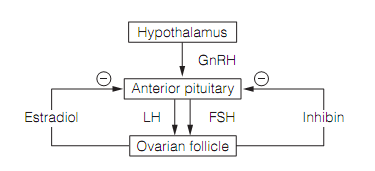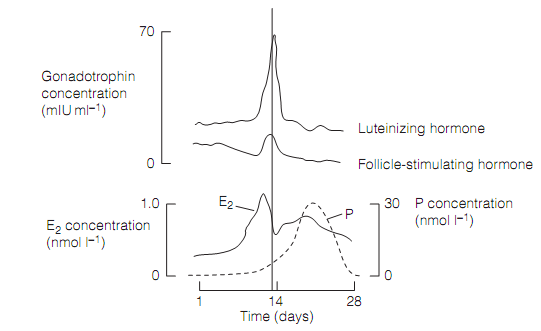Control in females
In females, the circumstances are more complex as the role of the HPG axis is to:
- Stimulate the growth of a class of ovarian follicles (one of that goes to maturity)
- Generate cyclical changes in sex steroid output that generates the reproductive tract for fertilization and implantation.
- Trigger ovulation at the suitable time.
The primary half of the cycle (in women which is usually 1–14 days) is the follicular phase, as it is dominated by the growth of the ovarian follicle that secretes estradiol and inhibin. The next half of the cycle is the luteal phase (15–28 days), as after ovulation the follicle becomes a corpus luteum that secretes progesterone.
Feedback depends on the phase of the cycle. For nearly all of the follicular phase low or moderate levels of estradiol, and inhibin, apply negative feedback effect on gonadotrophin secretion as shown in figure below.

Figure: Negative feedback inhibition during the follicular phase of the ovarian cycle. Negative feedback in males is very alike apart from that luteinizing hormone (LH) is regulated by testosterone from the testis. Here, FSH=follicle stimulating hormone; and GnRH=gonadotrophin releasing hormone.

Figure: Pattern of hormone secretion during the human ovarian cycle. Ovulation, triggered by the estradiol (E2) reminded surge in luteinizing hormone takes place around day 14. Here, P=progesterone; and mIU=milli-international units.
Though, by about day 14, levels of estradiol become high sufficient to flip the HPG axis into a positive feedback mode. Now the estrogen stimulates a increase in LH and FSH secretion that triggers ovulation, and toggles the steroid metabolism of the post-ovulatory follicle to generate progesterone as shown in figure. The rise in progesterone secretion at the beginning of the luteal phase terminates the positive feedback LH surge and the system reverts to negative feedback mode.